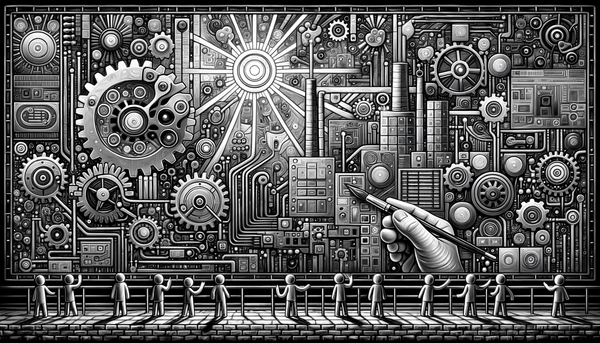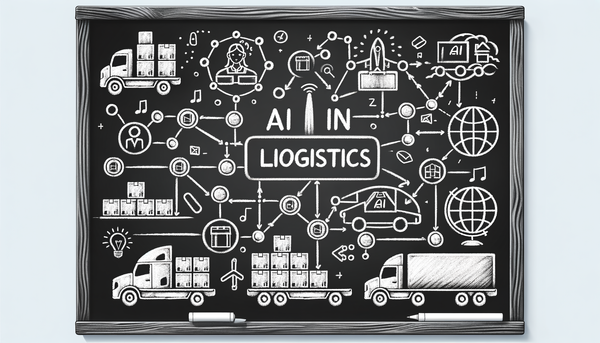CTV Ad Buyers and the Future of Generative AI
Deep learning innovations are rewriting the rules of everyday tech—from the omnipresent AI in Chinese devices to playful yet thought-provoking digital doppelgängers in gaming and social media.
China’s AI Renaissance: The Ubiquity of DeepSeek
Over the past year, China has experienced an AI renaissance powered by the homegrown model DeepSeek. Launched in January, DeepSeek has rapidly integrated into a multitude of sectors, demonstrating astonishing versatility. Automakers like Geely are embedding its advanced reasoning to create cars that not only navigate roads but also respond to subtle driver cues—transforming a simple cruise into an opportunity for a rejuvenating pause. Likewise, smartphone manufacturers such as Huawei and Oppo have leveraged DeepSeek to power next-generation voice assistants that blend seamlessly with consumer lifestyles.
In an unexpected twist, household appliances have joined the AI bandwagon. Midea’s “understanding friend” air conditioners, for instance, adjust their settings based on recognized user sentiments. This smart technology brings a blend of convenience and emotional connection to everyday tasks. More intriguing is the role of DeepSeek in healthcare, where over 100 hospitals cautiously integrate AI into diagnostics and medical record management. The balance between innovation and human oversight in clinical decisions is delicately managed, emphasizing the necessity for human expertise alongside AI capabilities.
Government bodies have also embraced DeepSeek, particularly in cities like Shenzhen, where administrative processes have become markedly more efficient. Document generation and expedited approvals have not only streamlined urban governance but also underscored China’s broader national strategic ambitions. The enthusiasm around DeepSeek is a reflection of a patriotic race among Chinese companies to harness AI’s potential, setting the stage for global competitive dynamics.
Entertainment and Social Innovation: When AI Meets Pop Culture
The narrative of AI innovation isn’t confined to industries like automotive or healthcare; it extends into the realms of gaming and social media, where its impact is both transformative and contentious. Sony’s recent unveiling of an AI-powered version of Aloy—a nod to the protagonist of the acclaimed game Horizon Zero Dawn—has stirred both amusement and concern among fans. The irony is palpable: a character originally crafted as a testament to human ingenuity is now rendered through the lens of algorithmic precision, a change that many see as a self-referential commentary on technology itself.
Online communities, particularly on Reddit, have relished the humorous twist. One fan noted the paradox that while the game cautions against unchecked technological takeover, Sony’s move seems to embody it. This stirring dialogue among enthusiasts highlights a broader debate about creativity versus automation in the entertainment industry. Actress Ashly Burch, whose voice brought Aloy to life, voiced support for protecting creative talents, underscoring the vital importance of preserving human elements in digital narratives.
Beyond gaming, Snapchat is also stepping up its AI game, offering a series of enchanting video filters. With AI-powered enhancements that introduce animated foxes, playful raccoons, and blooming spring flowers, the tech behind these filters leverages Snap's proprietary generative AI. The journey from high-tech development to everyday fun demonstrates how AI is not just a tool for efficiency—it’s also a medium for creative expression. Although available exclusively for premium users, this innovation is carving a niche in augmented reality, inviting users to experience digital magic in real time.
Revolutionizing Marketing and Business: The Agentic and Generative Divide
As artificial intelligence continues to evolve, its intersection with business strategy has become one of the most dynamic battlegrounds in recent times. Deloitte Digital is actively exploring both agentic AI—where machines autonomously achieve specified goals—and generative AI, which excels at creating compelling content. The firm’s Marketing Gen AI Lead, Jenny Kelly, offers an insightful breakdown of the two, revealing that while agentic AI carries significant potential, legal intricacies, especially with respect to copyright, make generative AI the more viable option at present.
Generative AI is emerging as a cornerstone in quickly producing cost-effective marketing content while adhering to regulatory frameworks. Industries ranging from finance to healthcare are testing these waters, carefully measuring performance metrics to validate return on investment. This cautious but optimistic approach reflects an understanding that while AI is a powerful tool for content creation and operational streamlining, it must be implemented with a clear business strategy and rigorous evaluation methods.
In the healthcare sector, the integration of AI has reaped impressive benefits. During a recent conversation with Jim Swanson, CIO of Johnson & Johnson, it became evident that a three-tiered approach to AI was not only boosting productivity and streamlining operations but also accelerating clinical trials. The integration of AI in clinical environments has led to a 2.6-fold increase in patient enrollment at efficient trial sites, showcasing AI's potential to enhance patient outcomes while ensuring systematic inclusion of diverse populations.
Such business transformations are not restricted to one industry. Across the board, administrators and strategists alike are navigating the complexities of AI implementation—from managing trust and performance metrics in marketing campaigns to redefining healthcare practices. In many ways, this evolution mirrors debates in traditional business circles, where technology is both a catalyst for innovation and a source of operational challenges.
Expanding AI’s Reach: Autonomous Interfaces and Practical Applications
While marketing and entertainment capture the public’s imagination, practical applications of AI in everyday tools and services are deepening its impact on society. One notable development comes from the Azure AI Foundry, which has introduced a “computer-using agent” designed to interact autonomously with graphical user interfaces. This technology represents a significant step toward making systems more intuitive, potentially transforming how users interact with software across numerous industries. Imagine a future where AI not only supports routine tasks but also navigates complex software environments on its own, further reducing reliance on manual inputs.
Back in China, the adoption of DeepSeek by government entities for administrative processes offers a real-world glimpse into how autonomous systems can enhance civic management. The swift document creation and processing efficiency gains in cities like Shenzhen hint at a future where bureaucracy may be revolutionized through AI-enabled workflows. These advancements are thrilling, especially as they align with broader strategic initiatives in tech-driven governance.
Meanwhile, the integration of AI into consumer gadgets continues unabated. From smart vehicles that understand vague commands to personal assistants in smartphones, these innovations are smoothing the path toward a fully connected digital ecosystem. A quote by A.R. Merrydew resonates in this context:
Mastering the technology to create effigies of ourselves, will be our downfall.
Although this sentiment underscores a note of caution, it also provokes reflection on the balance between convenience and overreliance on automation.
Innovation Meets Skepticism: The CTV Ad Buyers’ Perspective
Despite the bright prospects and undeniable convenience offered by AI, significant skepticism remains—particularly in areas where precision and brand integrity are non-negotiable. In the realm of Connected TV (CTV) advertising, for instance, ad buyers express deep reservations about entrusting generative AI with high-stakes campaigns. The reality is simple: while generative AI can produce rapid and cost-effective content, there is an underlying risk that its output might lack the nuanced authenticity necessary for national ad campaigns.
Industry executives have voiced concerns akin to “when it’s the biggest screen in front of millions of people, it better look good.” This perspective was vividly captured during a CTV Connect roundtable where participants questioned the reliability of fully automated creative solutions. The backlash experienced by some brands—such as the widely publicized controversy surrounding a Coca-Cola holiday spot—serves as a cautionary tale, reminding us that even the most advanced algorithms can sometimes miss the human touch.
Moreover, research from the World Federation of Advertisers points out that about 80% of major brands, which spend billions on marketing annually, remain cautious about the unchecked use of AI. These concerns highlight the need for a balanced approach, where technological integration in advertising is pursued alongside stringent quality controls and human oversight.
Envisioning the Road Ahead: Integration, Adaptability, and the Future of AI
Looking to the future, the path of artificial intelligence is one marked with opportunities, challenges, and a transformative vision. In the healthcare sector, for example, Johnson & Johnson’s multi-tiered strategy not only increases operational efficiency but also redefines the possibilities of patient care and clinical research. Their ambition to merge AI with emerging technologies like quantum computing reflects a broader trend among industry leaders: a relentless pursuit of innovation balanced by careful risk assessment.
In marketing and entertainment, firms like Deloitte Digital are advocating for a pragmatic approach to AI adoption—one that champions clear business objectives and measured implementation. This balanced approach is crucial, as companies navigate the evolving legal and ethical landscape surrounding AI, especially in relation to copyright and creative ownership.
As companies experiment with various implementations, the conversation around AI’s role becomes ever more nuanced. Amid concerns about depersonalization and algorithmic monotony, creative industries are advocating for technologies that complement rather than replace human contributions. This sentiment finds echoes in the words of Elon Musk, who once remarked on the rapid pace at which AI is evolving, a pace that demands both awe and careful oversight.
The story of AI is one of contrasts—where playful experimentation meets serious business strategy, and where technological prowess coexists with human creativity. It is a journey punctuated with dazzling breakthroughs, occasional setbacks, and a constant drive to refine how we interact with our increasingly digital world.
Innovation, after all, is rarely a straight path. As we stand on the brink of a new era, the question is not merely about what AI can do, but rather how we can use it responsibly to enhance our lives. Today’s advancements, from autonomous GUI interactions to sophisticated content generators, promise a future where the blend of human insight and machine precision could redefine how we live, work, and interact.




